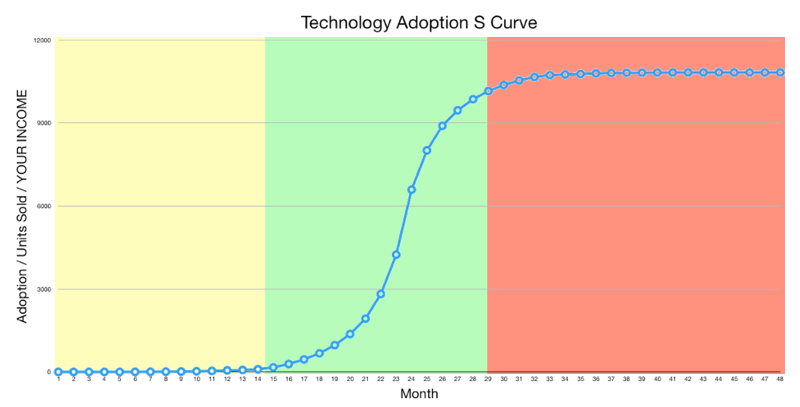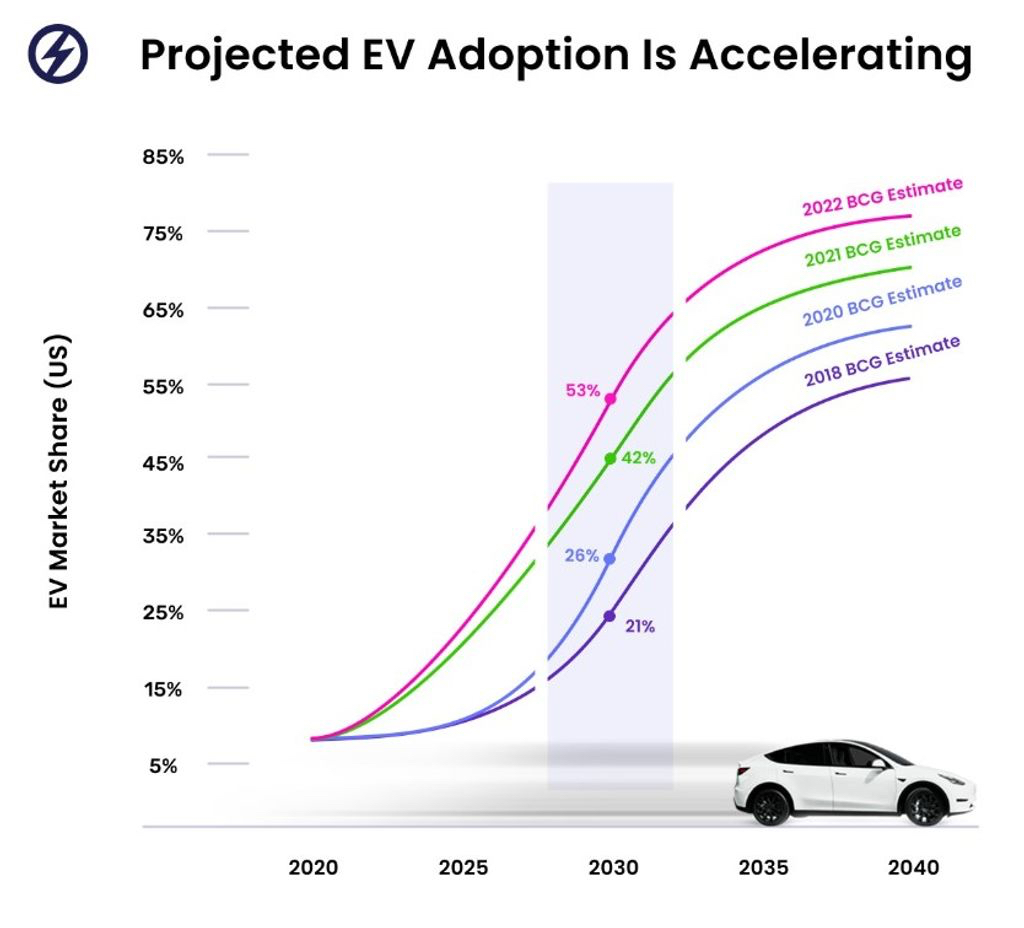Calling the next Musk, Bezos, Jobs, etc.:
Inside EVs published an interesting article on electric vehicle adoption rates and how they’re changing. I’ve written, and spoken publicly, many times about the “S curve of adoption,” and how it shows that adoption is non-linear. In the early months/years of a new technology, sales are slow. This is the realm of the “early adopters” (like me). Early adopters are either those enamored with new ideas or those who have done the math and realized that EVs represent a very attractive reduction in transportation costs or negative environmental impact while providing a great driving experience.

Once we get past the early adopter stage (green area in chart), sales pick up dramatically, as shown in the image above. In my opinion, we are now in the post-early adopter stage and sales are showing the acceleration in adoption I’ve been predicting, but here’s the really interesting part: Actual sales results as well as multiple projections, based on sales, keep going up as newer and newer data becomes available. In other words, the projections for adoption have also accelerated. The chart below shows projections by Boston Consulting Group that were published over the years 2018 to 2022. Every newer projection shows a remarkable increase over BCG’s own previous projections. The results (sales) keep improving beyond expectations to improve estimates for the future. Interest in, and optimism for, EVs keeps growing!

These results and projections occurred over a period when EV availability was very heavily affected by reduced EV availability, due to COVID-19, vehicle recalls, supply chain problems and raw materials availability. Over time, these negative pressures will disappear. Vehicle and battery manufacturers are announcing new factories, in order to qualify their vehicles for the Federal Income Tax Credit for EVs & PHEVs, which was changed by the Inflation Reduction Act. New lithium deposits are being announced on a regular basis and both mining and refinement of Lithium are becoming much larger industries in the U.S. (even more jobs). (see here, here, here & here) This will dramatically shorten the supply chain for many manufacturers. New job opportunities at these factories will revitalize the U.S. iron belt as well as the U.S. south, and will quiet the anti-EV narrative as a job killer for fossil fuel jobs. At the same time new jobs are being created in EV manufacturing, new jobs are also being created in renewable energy to improve grid resiliency and security as well as to support the electrification of transport. New developments in battery and electric motor design are steadily reducing the rare minerals currently required for production, which should drive down cost and increase demand. Finally, the Inflation Reduction Act is also funding the build-out of charging infrastructure, allowing those who cannot charge at home to make the switch to EVs without trepidation.
It’s this last point I want to discuss.
For the majority of Americans, who can charge an EV at home or at work, charging infrastructure is a non-issue, except for very long road trips through certain areas. Once the residential charging concerns are eliminated, EV adoption will suddenly accelerate again, when all those apartment dwellers jump on the EV bandwagon.
So, how do we accelerate this development?
Believe it or not, I believe it requires a big push in Level 2 charger installations. The government is working hard for DC fast charger installation, but there needs to be an emphasis on Level 2 as well. DC fast chargers are very expensive, typically costing more than $150K each, to procure and install. I’ve bought Level 2 chargers for less than $500 per charger. Yes, they’re much slower than DC fast charging, but also much easier on the vehicle’s battery, generating less heat. We just need someone to show us that using much slower chargers won’t negatively affect our lifestyle.
Here’s my pitch:
Imagine, as an apartment dweller, that you start to consider recharging to be like refueling an ICE vehicle. Like going to a gas station, you would recharge only once a week or so. You would drive to a parking lot, near your apartment or workplace, with Level 2 chargers at every single parking spot. Maybe the lot would be completely covered by solar canopies that supply electricity to the chargers (or grid) while keeping your EV in the shade. Adding energy storage, at some point, would help the grid by gathering energy, during the day, when demand is typically high and have the added benefit of insulating the lot from rising electricity rates. You would pull up to the gate, where you would be greeted by the attendant. The attendant would take your keys and put you in an autonomous vehicle for the short ride to your home or job. A valet would move your EV to a charge spot and plug it in. If you opt for the optional upcharge, your car could be washed, vacuumed, have the tires and windshield reservoirs refilled or have the state inspection or registration renewal handled for you! A the end of your restful night’s sleep, or day at work, you’d use a smartphone app to summon the autonomous vehicle to take you back to your fully charged EV. You’d pay a monthly fee for this service, of course, but you’d get to enjoy electric driving without having to move to a new home with a place to charge. This would also help older apartment complexes, without the electric infrastructure to support multiple chargers, to attract residents, instead of falling into irrelevance as consumers decide where to live, based on their ability to drive an EV while living there. EV charging is going to become the granite countertops of the 2020s for apartment complexes, an amenity that tips the scale in favor of the locations that support charging. Hell, the apartment complex may even add the monthly charging fee to the rent so you don’t even have an extra bill to pay each month! Businesses may add a shuttle service to and from the lot, so you don’t have to wait for the autonomous shuttle. In areas of high multi-family home density, the apartments may even join together to build lots, nestled within their area. The charging lots would have to have a fenced perimeter to secure the EVs and chargers. Due to this they should provide much lower incidence of charger and/or EV vandalism or damage due to negligence/laziness (not putting charge cord away after charging). Businesses may also jump into the game by pooling resources and installing charging lots near their locations, when they cannot install chargers there. EV charging will become the matching 401-K benefit, healthcare coverage or paid vacation of the 2020s, enabling employers to attract a forward-looking, progressive workforce that loves commuting to the office each day.
An additional benefit of this business model is its continued usefulness, if we transition to vehicle subscription/sharing. Those shared, autonomous vehicles will also need a centralized place to have them be recharged, have the interiors cleaned/sanitized and have routine maintenance performed, etc. These lots would be perfect for this and would help ease the transition to shared vehicle ownership by giving the lots the dual purpose of servicing privately owned EVs as well as subscription vehicles, with zero additional development costs.
Add to this scenario mass adoption of inexpensive Level 2 chargers at hotels and motels. Here’s a thought: Some of your EV charging, on a long road trip, does not have to slow your journey even as much as refilling with gasoline! Imagine a time when you don’t have to call ahead to see if your hotel of choice has an EV charger. Imagine they have a bank of ten, twenty or more, accessible by and/or chargeable to your room key. (of course, a Level 2 charge may be offered, without a cost, to attract EV customers, since it’s so inexpensive.) You would charge as you have dinner and/or sleep, which only delays your trip by the few seconds it takes to plug in your EV!
So there it is, free of charge, my business idea. Who wants to be a millionaire billionaire? Now, go make it so!

